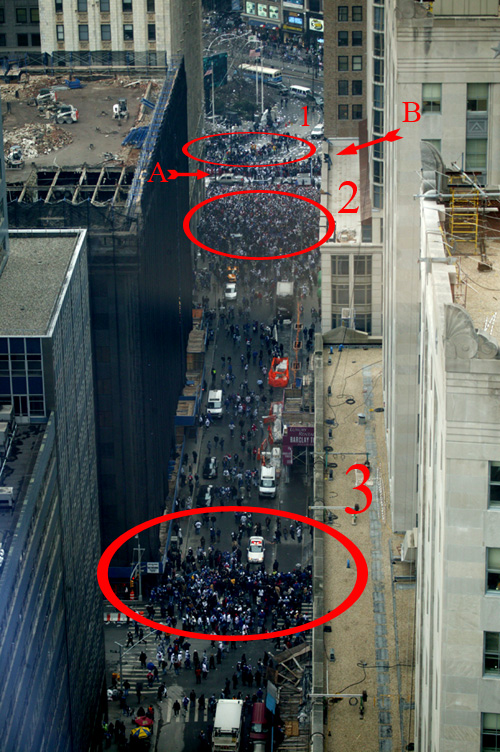New York City is well known for two types of public celebrations: New Year’s Eve in Time Square and Ticker-Tape parades.
New York City streets are like a 300 pound person in McDonalds: it seems that his or her arteries are so clogged with cholesterol that it’s impossible to clog them any more. Watching NYC streets during a celebration it’s like watching Homer Simpson eat 100 ribwiches. But New York City’s Finest and Strongest have crowd control down to a science, and people and garbage clots get dislodged very fast.
There are three major groups in an NYC public celebration: tourists, local shmoes, pros, and those who work there. Four major groups.
Let’s take a look at the following picture that I took out of my new workplace during the ticker tape parade thrown for the New York Giants.

Arrow with the letter A points to the actual parade: a float with football players going down the Canyon of Heroes. Number 1 denotes the group that came prepared and staked out spots right along the parade path. These are the pros: the showed up long before NYPD blocked the exits and stuck it out for the next several hours. Group number 2 is the clueless parade goers who showed up late, had to walk for a dozen of blocks that were blocked by police looking for a way to get closer to the parade, finally giving up and standing shoulder to shoulder in a humongous mass of people. They can’t see anything interesting.
During New Year’s eve this group is held in place by mounted policemen who, believe it or not pack the crowd in by backing their horses in sideways.
Group number 3 is all the people looking for a path to get into group 2 and those who are late for work and are trying to see a break in the police barricade.
Arrow B points to a more civilized way to enjoy the parade, but it required employment in one of the building next to a celebration.
NYC celebrations remind me of the Soviet times and the May Day parades. The trick was to leave from about 3/4 from the end of the parade, otherwise you reached a fenced in area and could not leave for hours having to listen to communist functionaries giving speech after speech.
I have some advice for those who want to enjoy a ticker tape parade or an NYE celebration in Manhattan:
- Reconsider: you will be crowded by people on all ends and freezing cold for hours. Definitely reconsider if you are claustrophobic, germophobic, have a weak bladder, or don’t like to come into contact with police horse’s ass.
- Show up before the cops block the street. This means at least 3 hours before the start. The best way to do so is to find a restaurant and spend your time there: remember – it will likely be cold.
- If you are a bit late, your best bet is getting out of a subway station right on the parade’s path: these get blocked off pretty late.
- Have a meal somewhere nearby and show up when most of the people left and the cleanup crews have arrived: this is usually more fun than the main event: you can take all the pictures and watch tons of confetti and garbage cleaned up in a matter of minutes.
- Do not reach out with your hand and scratch police horse’s ass. Just believe me on this one.
